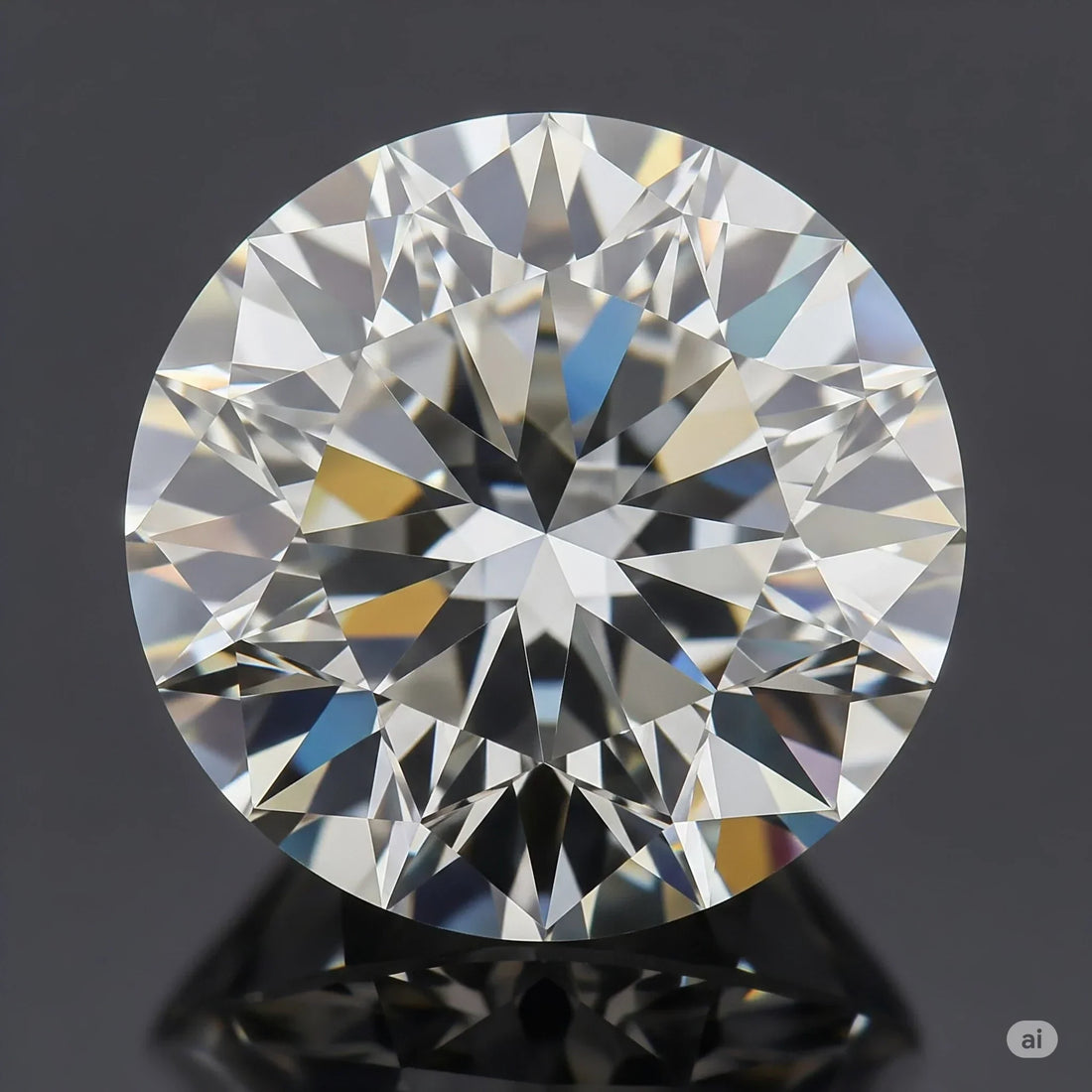
Lab Grown Diamonds vs Natural Diamonds: Complete 2025 Comparison Guide
Share
Planning your engagement and feeling overwhelmed by diamond choices? You're not alone. With engagement ring costs averaging $5,500 and ethical concerns about traditional mining practices growing, many couples are discovering lab grown diamonds as a compelling alternative. This comprehensive guide breaks down everything you need to know about lab grown diamonds vs natural diamonds, helping you make an informed decision that aligns with your values and budget.
How to Choose the Perfect Gold Hoops for Your Face Shape & Elevate Your Jewelry Game /Are Lab Grown Diamonds Good for Engagement Rings? Expert Insights
What Are Lab Grown Diamonds?
Lab grown diamonds, also known as synthetic diamonds, man made diamonds, or lab created diamonds, are real diamonds created in controlled laboratory environments. These diamonds possess identical physical, chemical, and optical properties to natural diamonds, formed through advanced technological processes that replicate the extreme heat and pressure conditions found deep within the Earth.
The Science Behind Lab Created Diamonds
Two primary methods create synthetic diamonds:
High Pressure High Temperature (HPHT): This process mimics natural diamond formation by subjecting carbon to extreme pressure (over 1.5 million pounds per square inch) and temperatures exceeding 2,700°F.
Chemical Vapor Deposition (CVD): This newer method uses a carbon-rich gas mixture in a vacuum chamber, where carbon atoms slowly deposit onto a diamond seed, building the crystal layer by layer.
Both methods produce genuine diamonds that are chemically identical to their natural counterparts, containing pure carbon arranged in the same crystal lattice structure.
Natural Diamonds: The Traditional Choice
Natural diamonds form over billions of years deep within the Earth's mantle, where carbon undergoes intense heat and pressure. These precious stones reach the surface through volcanic eruptions, creating the diamond deposits that have captivated humanity for centuries.
The Journey of Natural Diamonds
The formation process of natural diamonds spans 1 to 3.5 billion years, occurring 90 to 120 miles beneath the Earth's surface. This extraordinary timeline contributes to their perceived rarity and romantic appeal, making them the traditional symbol of eternal love and commitment.
Lab Grown Diamonds vs Natural: Key Differences
Physical and Chemical Properties
Identical Composition: Both lab grown diamonds vs natural diamonds consist of pure carbon atoms arranged in the same crystal structure. They share identical hardness (10 on the Mohs scale), brilliance, fire, and scintillation.
Visual Appearance: To the naked eye, synthetic diamonds and natural diamonds are indistinguishable. Even trained gemologists require specialized equipment to differentiate between them.
Durability: Man made diamonds offer the same exceptional durability as natural diamonds, making them equally suitable for daily wear in engagement rings and other jewelry.
Cost Comparison
The most significant difference lies in pricing. Lab created diamonds typically cost 30-50% less than comparable natural diamonds, offering substantial savings for budget-conscious couples.
Natural Diamond Pricing:
- 1-carat natural diamond: $4,000-$8,000
- 2-carat natural diamond: $12,000-$25,000
Lab Grown Diamond Pricing:
- 1-carat lab grown diamond: $1,500-$3,000
- 2-carat lab grown diamond: $4,000-$8,000
This price difference allows couples to either save money or invest in a larger, higher-quality stone within their budget range of $1,500-$5,000.
Ready to make an informed diamond decision? Download our Free Diamond Comparison Checklist to evaluate your options systematically and ensure you're getting the best value for your investment.
Ethical Considerations
Lab Grown Diamond Ethics
Synthetic diamonds offer a conflict-free alternative that addresses many ethical concerns associated with traditional diamond mining:
Environmental Impact: Lab created diamonds require significantly less land disruption and water usage compared to mining operations.
Labor Practices: Man made diamonds eliminate concerns about worker exploitation and unsafe mining conditions.
Conflict-Free Guarantee: Lab grown diamonds provide complete assurance against funding conflicts or human rights violations.
Natural Diamond Ethics
The natural diamond industry has made substantial improvements through initiatives like the Kimberley Process, which aims to prevent conflict diamonds from entering the market. However, some ethical concerns remain:
Environmental Impact: Diamond mining involves significant land excavation and ecosystem disruption.
Community Impact: While mining can provide economic opportunities, it may also displace communities and affect local environments.
Supply Chain Transparency: Tracking the complete journey of natural diamonds can be challenging despite certification efforts.
Quality and Certification
Grading Standards
Both lab grown diamonds vs natural diamonds receive grading from the same prestigious institutions:
Gemological Institute of America (GIA): Provides comprehensive grading reports for both diamond types using identical criteria.

International Gemological Institute (IGI): Offers detailed certification for synthetic diamonds and natural diamonds.
American Gem Society (AGS): Evaluates both diamond types using their rigorous grading standards.
The 4 Cs Comparison
Cut: Both diamond types can achieve excellent cut grades, maximizing brilliance and fire.
Color: Lab created diamonds often exhibit superior color consistency, with many achieving D-F colorless grades.
Clarity: Man made diamonds frequently display fewer inclusions due to controlled growing conditions.
Carat: Synthetic diamonds offer more flexibility in carat weight selection within budget constraints.
Investment Value and Resale
Natural Diamond Investment
Natural diamonds traditionally hold their value better over time, though they rarely appreciate significantly. The resale market for natural diamonds is more established, with jewelry stores and dealers readily accepting them for trade-ins or purchases.
Lab Grown Diamond Investment
Lab grown diamonds currently have lower resale values due to their newer market presence and continued price decreases as technology improves. However, for couples prioritizing the diamond's symbolic meaning over investment potential, this factor may be less significant.
Wondering which diamond type aligns with your priorities? Our Free Diamond Comparison Checklist helps you weigh investment considerations against your personal values and budget constraints.
Popular Myths Debunked
Myth 1: Lab Grown Diamonds Are Fake
Reality: Synthetic diamonds are genuine diamonds with identical chemical composition and physical properties to natural diamonds. They're not diamond simulants like cubic zirconia or moissanite.
Myth 2: Lab Created Diamonds Look Different
Reality: Man made diamonds are visually indistinguishable from natural diamonds without specialized equipment. They exhibit the same brilliance, fire, and scintillation.
Myth 3: Lab Grown Diamonds Are Lower Quality
Reality: Lab created diamonds often display superior quality characteristics due to controlled growing conditions, resulting in fewer inclusions and better color consistency.
Myth 4: Natural Diamonds Are Always More Valuable
Reality: While natural diamonds currently maintain higher resale values, the primary value of an engagement ring lies in its emotional significance rather than investment potential.
Choosing the Right Diamond for You
Consider Your Priorities
Budget-Conscious Couples: Lab grown diamonds offer exceptional value, allowing you to maximize size and quality within your $1,500-$5,000 budget range.
Ethically-Minded Buyers: Synthetic diamonds provide complete peace of mind regarding environmental and social impact.
Tradition-Focused Couples: Natural diamonds offer the romantic appeal of billions of years of formation and established cultural significance.
Quality-Seekers: Both diamond types can achieve exceptional quality grades, with lab created diamonds often offering superior clarity and color consistency.
Making Your Decision
Consider these factors when choosing between lab grown diamonds vs natural:
- Budget allocation and priorities
- Ethical values and environmental concerns
- Long-term investment considerations
- Personal preference for tradition vs innovation
- Desired diamond size and quality characteristics
Ready to compare your options systematically? Download our Free Diamond Comparison Checklist to evaluate each factor and make a confident decision that reflects your values and budget.
Shopping Tips and Best Practices
Research Reputable Retailers
Whether choosing synthetic diamonds or natural diamonds, select retailers with:
- Proper certification from recognized gemological institutes
- Transparent pricing and return policies
- Positive customer reviews and industry reputation
- Comprehensive warranties and after-sale services
Certification Requirements
Always insist on proper certification regardless of diamond type:
- GIA reports for comprehensive grading analysis
- IGI certification for detailed quality assessment
- Laser inscription for diamond identification and verification
Setting and Style Considerations
Both lab grown diamonds and natural diamonds work beautifully in all engagement ring settings:
- Solitaire settings showcase the diamond's natural beauty
- Halo designs maximize visual impact and perceived size
- Three-stone rings offer symbolic meaning and enhanced brilliance
- Vintage-inspired settings complement both diamond types elegantly
Future Trends and Market Outlook
Growing Acceptance
Lab created diamonds are gaining mainstream acceptance, particularly among millennials who prioritize value and ethics. Industry projections suggest continued growth in the synthetic diamond market as technology advances and awareness increases.
Technology Improvements
Ongoing technological developments in diamond growing processes continue to improve quality while reducing costs, making man made diamonds increasingly attractive to budget-conscious couples.
Market Evolution
The diamond industry is evolving to accommodate both natural and lab grown options, with many traditional retailers now offering synthetic diamonds alongside their natural diamond collections.
Frequently Asked Questions
Are lab grown diamonds real diamonds?
Yes, lab grown diamonds are real diamonds with identical chemical, physical, and optical properties to natural diamonds. They consist of pure carbon arranged in the same crystal lattice structure and exhibit the same hardness, brilliance, and durability.
Can jewelers tell the difference between lab grown and natural diamonds?
Trained gemologists can distinguish between lab grown diamonds vs natural diamonds using specialized equipment that detects subtle differences in crystal growth patterns and trace elements. However, these differences are invisible to the naked eye.
Do lab created diamonds test as real diamonds?
Yes, synthetic diamonds test as real diamonds on standard diamond testers because they possess identical thermal and electrical conductivity properties. Specialized equipment is required to identify their laboratory origin.
Will lab grown diamonds hold their value?
Lab grown diamonds currently have lower resale values compared to natural diamonds, though this may change as market acceptance grows. However, engagement rings are primarily emotional investments rather than financial ones.
Are lab grown diamonds more environmentally friendly?
Generally yes, lab created diamonds have a smaller environmental footprint than mined natural diamonds, requiring less land disruption, water usage, and energy consumption per carat produced.
How long do lab grown diamonds take to create?
Depending on the method used, synthetic diamonds can be grown in several weeks to a few months, compared to the billions of years required for natural diamond formation.
Can lab grown diamonds be insured like natural diamonds?
Yes, man made diamonds can be insured with the same coverage options as natural diamonds, provided they have proper certification and appraisal documentation.
Still have questions about choosing between lab grown and natural diamonds? Our Free Diamond Comparison Checklist includes additional resources and expert insights to guide your decision-making process.
Making Your Final Decision
The choice between lab grown diamonds vs natural diamonds ultimately depends on your personal values, budget, and priorities. Both options offer genuine diamonds that will beautifully symbolize your commitment and love.
Lab created diamonds provide exceptional value, ethical peace of mind, and identical beauty at a fraction of the cost, making them ideal for couples who prioritize budget efficiency and environmental responsibility. Natural diamonds offer traditional appeal, established market value, and the romance of billions of years of natural formation.
Consider your relationship's unique story, values, and financial goals when making this important decision. Whether you choose synthetic diamonds or natural diamonds, you're selecting a symbol of your love that will last a lifetime.
Remember that the most important aspect of your engagement ring isn't whether your diamond formed in a laboratory or deep within the Earth—it's the love and commitment it represents. Both lab grown and natural diamonds will sparkle just as brilliantly on your finger and in your memories for years to come.
Take time to research, compare options, and choose the diamond that feels right for your relationship. With proper certification and a reputable retailer, either choice will result in a beautiful, lasting symbol of your love story.
